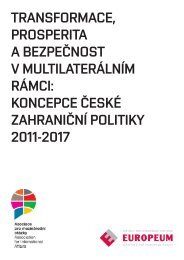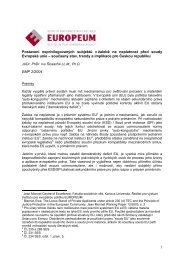eu constitutionalisation - EUROPEUM Institute for European Policy
eu constitutionalisation - EUROPEUM Institute for European Policy
eu constitutionalisation - EUROPEUM Institute for European Policy
You also want an ePaper? Increase the reach of your titles
YUMPU automatically turns print PDFs into web optimized ePapers that Google loves.
Chapter 3: The 2004 IGC: Bargaining or Learning?EU sanctions against Austria when it voted into power an extreme right-wingparty (interview, op. cit). Accounts of the Irish presidency also depict a closealliance with British governments and a mutual knowledge between Britishand Irish governments about the other’s behaviour and preferences basedon its close relationship in devising policy towards Northern Ireland.In the Irish presidency, the aim generally was to find a rational coherent way ofdealing with divisive bargaining issues. Moreover, the presidency by engagingin bilateral talks with leaders had a bird’s eye view of all state preferences and attimes had more knowledge overall than individual member states. Thus it wasable to instil a problem-solving approach to the IGC. While all states had theirpreferences, they sought a consensus, or package deal and acknowledged theimportance of reciprocity in bargaining. In short, in contrast to strict bargaining,even if state governments sought to achieve their aims, they tended to careabout the consequences of their bargain <strong>for</strong> others.Apart from the shadow of the future and the need to ensure future IGCagreements, there was an awareness that the Italian presidency had notdelivered a treaty and time was running out. The desire to reach an agreementby the end of the Irish presidency facilitated a problem-solvingapproach to negotiations <strong>for</strong> all states. Moreover, Azanar’s government’selection loss precipitated a warmer bargaining relationship between Franceand Spain, again lessening emphasis on zero-sum bargaining. Finally, in theprocess, it is noteworthy that the Commission played only a minor role. TheIrish presidency relied more on the Council secretariat, both <strong>for</strong> its political‘know-how’, but also <strong>for</strong> its drafting of the final texts. The Commission wasalways in<strong>for</strong>med of developments, but did not play a key role.The Dublin IGC exhibited a clear style of management with obvious success.However, from the above analysis, the international context was a vitalbackground to its success: the Convention process itself, cleavages aboutthe Iraq war, and the perceived need to reach a speedy agreement after theItalian presidency were significant factors. Clearly, a mixture of cross-cuttingand inter-state cleavages characterised the <strong>for</strong>mulation process of boththe draft constitutional treaty and the Convention. The bargaining processwas neither purely one of classical bargaining nor of arguing, but exhibitedcharacteristics of both <strong>for</strong>ms of negotiation Different constellations of stateswere on different sides of each institutional debate, depending on theissue at stake. Cleavages were national, not cross-cutting: shared commonChapter 3: The 2004 IGC: Bargaining or Learning?interests among all states on all issues did not typify negotiations. However,despite this, a problem-solving consensual approach existed.Overall, the case of the 2004 IGC highlights the increasing complexity of theEU environment. Cross-cutting cleavages do not yet dominate the actual IGCbargaining process. However, contrary to classical intergovernmentalism,there are shifting constellations of divided cleavages with shifting membership.Moreover, background factors: the Convention, the perception ofa limited timeframe to reach an agreement do constitute common interests,but not in the manner neo-functionalists and Europhiles would predict. TheConvention, as argued above, also reflected a package deal based on interstatecleavages. Overall, the three hypotheses drawn from an overview ofbargaining theory cannot be either fully falsified or validated:Hypothesis 1: The 2004 IGC reflected a bargaining process which allowed smallstates to achieve their strongest preference: partially valid: small states couldachieve interests where large states did not prioritise the specific interest.Hypothesis 2: The Dublin IGC provides evidence of joint-problem solving andconceptualisation: non-zero sum process: this hypothesis is valid, but the qualificationmust be made that on some issues such co-operative bargainingwas not possible.Hypothesis 3: The Dublin IGC bargaining process reflected the interests and controlof the more powerful states, not influence of the presidency or EU institution: justas the above two hypotheses have only partial validity, so too does thisintergovernmental hypothesis. The presidency did play a powerful mediatingrole. The institutional regime did appear to facilitate easier bargainingand small states did achieve some aims. However, where large states shareda consensus, their preferences prevailed (as Moravcisk would predict).The above analysis has illustrated the multi-faceted nature of the bargainingprocess and the added dimension of the convention’s draft that hada clear input into the constitutional treaty. The case of the Irish presidencyis neither one of arguing nor bargaining, but a cocktail of both strategies.94 95








